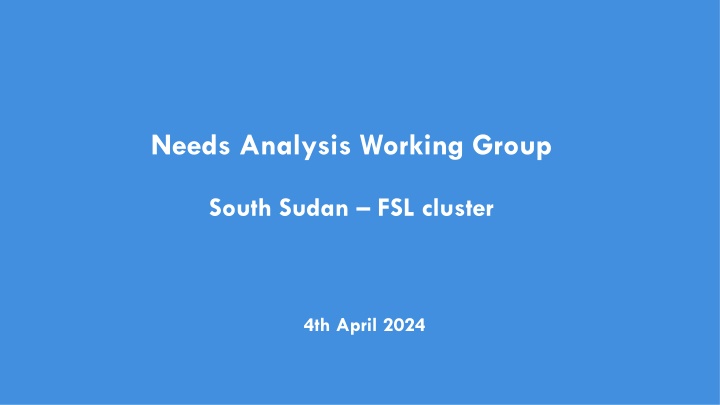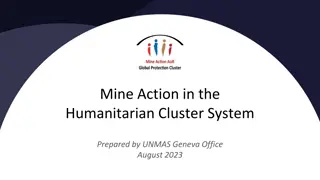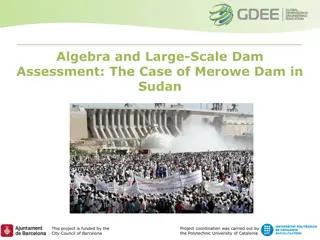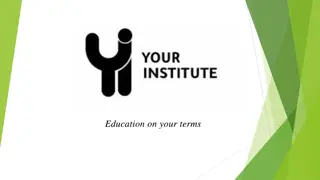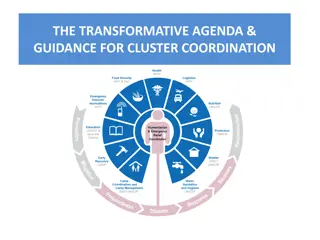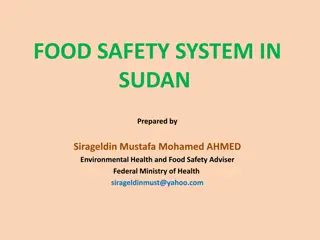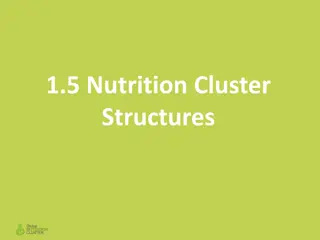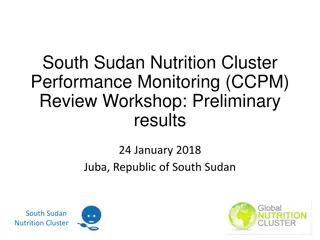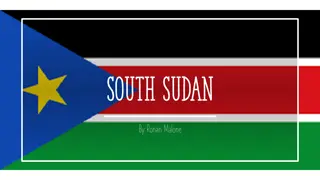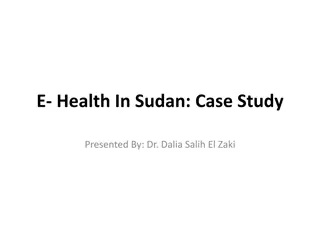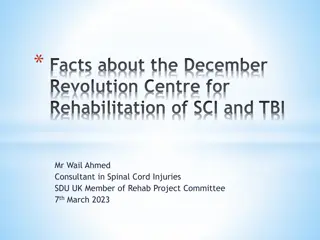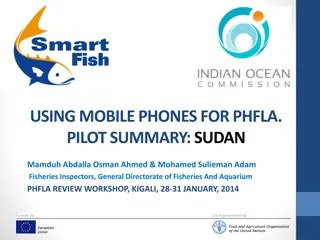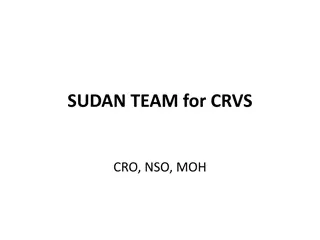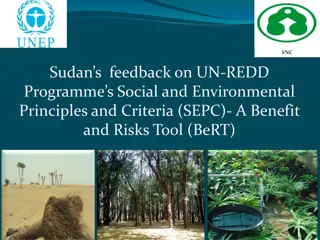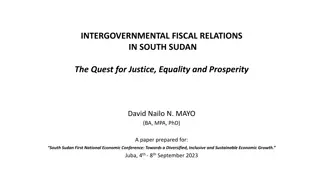Needs Analysis Working Group for South Sudan FSL Cluster - 4th April 2024
The Needs Analysis Working Group (NAWG) in South Sudan is focused on conducting evidence-based analysis of critical humanitarian needs to support decision-making for intersectoral emergency response. The group monitors needs severity, provides updates to the ICCG, and aims to prioritize the most vulnerable populations for assistance.
Download Presentation

Please find below an Image/Link to download the presentation.
The content on the website is provided AS IS for your information and personal use only. It may not be sold, licensed, or shared on other websites without obtaining consent from the author.If you encounter any issues during the download, it is possible that the publisher has removed the file from their server.
You are allowed to download the files provided on this website for personal or commercial use, subject to the condition that they are used lawfully. All files are the property of their respective owners.
The content on the website is provided AS IS for your information and personal use only. It may not be sold, licensed, or shared on other websites without obtaining consent from the author.
E N D
Presentation Transcript
Needs Analysis Working Group South Sudan FSL cluster 4th April 2024
Agenda Introduction to Needs Analysis Working Group (NAWG) NAWG methodology o Analytical framework and monthly analytical process Role of members Last months analysis
NAWG: Objective, Outputs, & Outcome Objective To conduct evidence-based and contextualized analysis of critical life-saving humanitarian needs across South Sudan to inform the ICCG s decision-making Outputs Regular monitoring of needs severity at the country level (monthly) Regular updates to the ICCG Outcome To inform and support the ICCG s efforts to ensure the most vulnerable people and places are prioritised for intersectoral emergency response through early and anticipatory action
ICCG and HCT first-level triggers 1. Reports of key protection concerns faced by displaced people and other affected populations. Heightened conflict related sexual violence, forced recruitment of children and targeted killings of civilians Deliberate destruction of civilian assets by armed actors inducing IPC 4 and above levels of food insecurity 2. IPC 4 (Emergency) and 5 (Catastrophic) levels of food insecurity. 3. Displaced population due to conflict or floods with the following thresholds: More than 20% of children and women affected by the event. Locations with more than 10% of IDPs compared to the host population. 4. Vulnerability Trigger Criteria: More than 10 % of female-headed households and other vulnerable-group headed households. More than 10% presence of persons with disabilities, increased number of (male and female) youth populations requiring structured engagement. 5. Disease outbreaks (including cholera, measles, meningitis, Rift Valley fever and malaria upsurges among others) as per WHO standards, disaggregated by age, sex and disability including physical type, sensory and mental.) 6. Increasing/high mortality as per WHO standards, disaggregated by age, sex and disability including physical type, sensory and mental.
Needs severity classifications Severity A Score range `8 - 10 Description of humanitarian conditions Extreme humanitarian conditions with people facing extreme shortages and/or availability and accessibility issues to meet basic needs. Affected populations face a complete lack of food and/or other basic needs, with evidence of acute malnutrition and food insecurity and reports of excess mortality. Severity B1 7 - 7.9 Severe humanitarian conditions with affected populations facing significant shortages and/or significant availability and accessibility problems in regards to basic services. People face severe food consumption gaps and have started to deplete their assets or already face an extreme loss of assets. This may result in very high levels of acute malnutrition and excess mortality. For an added layer of granularity, Band B has been split into two sub-classifications: B1 (corresponding to score 7 7.9) and B2 (corresponding to score 6 6.9) [change made in January 2023] Severity B2 6 - 6.9 Severe humanitarian conditions with affected populations facing significant shortages and/or significant availability and accessibility problems in regards to basic services. People face severe food consumption gaps and have started to deplete their assets or already face an extreme loss of assets. This may result in very high levels of acute malnutrition and excess mortality. For an added layer of granularity, Band B has been split into two sub-classifications: B1 (corresponding to score 7 7.9) and B2 (corresponding to score 6 6.9) [change made in January 2023] Severity C 4 - 5.9 Moderate humanitarian conditions with affected populations facing shortages and/or availability and accessibility problems in regards to basic services but they are not life-threatening. Significant food consumption gaps are visible. As a result of shortages and disruption of services, populations may face potentially life-threatening consequences if not provided with assistance. Severity D 2 - 3.9 Stressed humanitarian conditions with affected populations facing some shortages or/and some availability and accessibility problems in regards to basic services. People have some food gaps and food consumption is reduced but adequate are able to meet minimum food needs by applying coping strategies. There are strains on livelihoods. Needs are more increased but are still not life-threatening. Severity E 0 - 1.9 None/Minor humanitarian conditions with affected populations facing none or minor shortages or/and accessibility problems regarding basic services. People are able to meet food and other basic needs without having to apply to irreversible coping strategies. There may be some needs but are not life-threatening.
Member inputs on: Counties to be flagged for discussion on current needs severity Flagging a county for close monitoring
Role of Members Before the monthly NAWG meeting: Share reports, research etc. to be incorporated into monthly analysis on an ongoing basis Review dataset with classifications ahead of meeting Suggest counties to be discussed During the monthly NAWG meeting: Present on relevant assessments conducted or trends affecting needs severity Participate (in person, if possible) to ensure your expertise and inputs feed in Come prepared for counties to be discussed After the monthly NAWG meeting: Share any additional relevant information points that might been missed in discussion Cascade relevant NAWG information onwards Use to inform prioritisation discussion in the ICCG and other platforms where relevant
NAWG Needs Severity Classifications February-March 2024
First-level needs severity classifications for February-March 2024 Number of counties in different bands A = 1 B1= 7 B2 = 41 C = 23 D = 7 E = 0
Counties for contextual analysis Band (February- March) County Rationale Returnees from Sudan Arrive in Fangak County: On 26 February, the RRC in Fangak County reported the arrival of 642 individuals (107 households) into Fangak from Sudan, hosted by relatives and friends. This recent influx brings the total reported number of returnees from Sudan to Fangak to more than 3,900 people since November 2023, but the returnees are yet to be verified. The primary needs identified for these returnees are food and emergency shelter. Fangak B1 Partners on the ground are reporting a gap in WASH in Gomgoi and Nyindeng Ayuel IDP sites (access to sanitation etc) since no WASH partners are running WASH activities. These sites were supported by COSS and IOM, but they checked out in October 2023. From February 28 to March 2, 2024, OCHA conducted an IRNA in Wonduruba. Preliminary results indicate growing concerns in food security, livelihood, education, health, nutrition, protection, and NFIs. Emergency drugs, along with WASH and hygiene kits, were distributed to two health facilities and 250 households. Since April 2023, the Maban refugee response has managed two influxes of new arrivals due to the Sudan crisis. The first group was transported from Renk to Gendrassa Reception Center via Joda/Wunthow crossings, and the second, arriving on foot from Blue Nile State, entered through Al Foj to Gendrassa or Gufa/Shatta to Doro Reception Centers, starting November 2023. Twic B1 Juba B2 Maban B2 Escalating Insecurity Triggers Displacement in Kajo keji County: Since the start of 2024, Kajo keji County has experienced an uptick in security breaches, causing fear among residents. In January, heightened insecurity within and across the border with Uganda. This violence prompted the displacement of over 643 households from Dindiro and Maranga Villages, with some seeking refuge in Uganda and others at Litoba Centre for safety. The presence of cattle in Kajo keji raises concerns about continued insecurity and potential disruption of farming activities in certain Bomas Challenges persist in Kajo-Keji County, increasing vulnerabilities and hindering essential services. The withdrawal of WFP funding has resulted in inadequate stock for Supercereal Plus, alongside shortages of other essential medicines in certain facilities. 19 Feb report: 11,000 people were displaced from Bunno village and 10 others were injured in Lopua village when the two Toposa communities of Buno and Nganiya clashed over a water point for their cattle. Between 15th-16th Feb IRNA: Findings estimate that around 10,000 people have been displaced, of whom 7,500 are identified as in need of assistance. Shelter, non-food items and food are priority needs. The primary healthcare facility in Juoljok was reportedly looted, and the health facility in Abathok has not been stocked due to movement restrictions. The seasonal migration of around 3,000 herds of cattle from the Sudanese Misseriya ethnic group to Abyei, South Sudan has heightened tensions as herders search for water and pastures. Kajo keji C Kapoeta East C Abyei *
Fangak County UNDERLYING VULNERABILITY 1. Demographic vulnerability: High 2. % of IDPs and/or returnees: Very high 3. IPC 5-year average: High FIRST-LEVEL TRIGGERS 1. Protection: Moderate 2. Displacement: Moderate 3. Disease: Moderate 4. FSL: IPC P4 5. Malnutrition: IPC P4 FIRST-LEVEL NEEDS SEVERITY CLASSIFICATION: B1 CONTEXTUAL ANALYSIS Hotspots: Socio-economic-political dynamics: Mobility barriers: Economic shocks: Flood-affected people: Key groups affected: Specific needs: Access to assistance: Other: FINAL NEEDS SEVERITY CLASSIFICATION:
Twic County UNDERLYING VULNERABILITY 1. Demographic vulnerability: Moderate 2. % of IDPs and/or returnees: Very high 3. IPC 5-year average: High FIRST-LEVEL TRIGGERS 1. Protection: Moderate 2. Displacement: None 3. Disease: Very high 4. FSL: IPC P4 5. Malnutrition: IPC P4 FIRST-LEVEL NEEDS SEVERITY CLASSIFICATION: B2 CONTEXTUAL ANALYSIS Hotspots: (Ajak Kuac border areas) Socio-economic-political dynamics: Mobility barriers: Flood-affected people: Key groups affected: IDPs and returnees Specific needs: Access to assistance: Other FINAL NEEDS SEVERITY CLASSIFICATION:
Juba County UNDERLYING VULNERABILITY 1. Demographic vulnerability: High 2. % of IDPs and/or returnees: Very high 3. IPC 5-year average: High FIRST-LEVEL TRIGGERS 1. Protection: High 2. Displacement: High 3. Disease: High 4. FSL: P3 5. Malnutrition: IPC P2 FIRST-LEVEL NEEDS SEVERITY CLASSIFICATION: B2 CONTEXTUAL ANALYSIS Hotspots: (Transit sites) Socio-economic-political dynamics: Flood-affected people: Economic shocks: Key groups affected: Specific needs: Health Access to assistance: Other: FINAL NEEDS SEVERITY CLASSIFICATION:
Maban County UNDERLYING VULNERABILITY 1. Demographic vulnerability: High 2. % of IDPs and/or returnees: Very high 3. IPC 5-year average: Moderate FIRST-LEVEL TRIGGERS 1. Protection: Moderate 2. Displacement: Low 3. Disease: High 4. FSL: IPC P3 5. Malnutrition: IPC P4 FIRST-LEVEL NEEDS SEVERITY CLASSIFICATION: B2 CONTEXTUAL ANALYSIS Hotspots: Socio-economic-political dynamics: Flood-affected people: Economic shocks: Key groups affected: Specific needs: Access to assistance: Other FINAL NEEDS SEVERITY CLASSIFICATION:
Kapoeta East County UNDERLYING VULNERABILITY 1. Demographic vulnerability: Moderate 2. % of IDPs and/or returnees: Low 3. IPC 5-year average: High FIRST-LEVEL TRIGGERS 1. Protection: Moderate 2. Displacement: None 3. Disease: Moderate 4. FSL: IPC P3 5. Malnutrition: IPC P3 FIRST-LEVEL NEEDS SEVERITY CLASSIFICATION: C CONTEXTUAL ANALYSIS Hotspots: Socio-economic-political dynamics: Mobility barriers: Flood-affected people: Key groups affected: Specific needs: Access to assistance: Other: FINAL NEEDS SEVERITY CLASSIFICATION:
Abyei County CONTEXTUAL ANALYSIS Hotspots: Socio-economic-political dynamics: Mobility barriers: Economic shocks: Flood-affected people: Key groups affected: Specific needs: Access to assistance: Other:
Kajo Keji County UNDERLYING VULNERABILITY 1. Demographic vulnerability: High 2. % of IDPs and/or returnees: Very high 3. IPC 5-year average: High FIRST-LEVEL TRIGGERS 1. Protection: Moderate 2. Displacement: None 3. Disease: Moderate 4. FSL: IPC P3 5. Malnutrition: IPC P1 FIRST-LEVEL NEEDS SEVERITY CLASSIFICATION: C CONTEXTUAL ANALYSIS Hotspots: Socio-economic-political dynamics: Flood-affected people: Economic shocks: Key groups affected: Specific needs: Access to assistance: Other FINAL NEEDS SEVERITY CLASSIFICATION:
Counties flagged for close monitoring Band (February- March) County Rationale Due to the insecurity, the planned need assessment in Jur River County, Western Bahr el Ghazal has been postponed: The multi- sectoral assessment by humanitarian partners that was scheduled for 27 February to inform joint intervention to more than 29,088 people from Tharkueng payams of Jur River County who are affected by land disputes with the community from Warrap State has been postponed due to insecurity. Partners are monitoring the situation to reschedule the assessment. Any update on the humanitarian situation and whether the needs assessment was conducted. JurRiver B2 On February 19, 2024, a coordination meeting at Mandeng RRC Office discussed the humanitarian crisis due to recent insecurity, displacing approximately 28,600 people across Kurenge, Torpout, Koat, Panayang, Nquen, and Mandeng. A joint rapid needs assessment was conducted on February 22, with findings reported to OCHA via ADA on February 29. Key Concerns: Food: IDPs struggle to secure food. Health: Prevalence of malaria, cough, and flu. Shelter/NFI: Shelters are overcrowded. WASH: Lack of facilities leads to open defecation and reliance on river water. Luakpiny Nasir B2 On 21 February, the Government of Unity facilitated the relocation of more than 900 IDPs from Abyei area to Mayom County. IDPs in the Rumajak site received humanitarian assistance from partners in Abyei before departure, including a 30-day food ration, shelter and non-food items, nutrition supplies and dignity kits. A rapid protection assessment of the relocated IDPs in Mayom was conducted on 22 February. Findings included that the IDPs are seeking short-term shelter solutions, such as living under trees, and have limited access to basic services. Smaller numbers of IDPs from Abyei continue to arrive at the site. The state-level inter-cluster coordination group (ICCG) is monitoring the humanitarian situation. Mayom B2 Physical access to Boro Medina was difficult. Hundreds of returnees and refugees from Sudan there have very limited access to services. NAWG members are following up on the IRNA assessment findings conducted in Boro Medina. Raja C
Jur River County UNDERLYING VULNERABILITY 1. Demographic vulnerability: High 2. % of IDPs and/or returnees: Very high 3. IPC 5-year average: Moderate FIRST-LEVEL TRIGGERS 1. Protection: Low 2. Displacement: Very high 3. Disease: High 4. FSL: IPC P3 5. Malnutrition: IPC P3 FIRST-LEVEL NEEDS SEVERITY CLASSIFICATION: B2 CONTEXTUAL ANALYSIS Hotspots: Jur River Socio-economic-political dynamics: Flood-affected people: Economic Shocks: Key groups affected: IDPs and returnees Specific needs: Access to assistance: Other FINAL NEEDS SEVERITY CLASSIFICATION:
Nasir County UNDERLYING VULNERABILITY 1. Demographic vulnerability: Moderate 2. % of IDPs and/or returnees: Very high 3. IPC 5-year average: High FIRST-LEVEL TRIGGERS 1. Protection: Moderate 2. Displacement: None 3. Disease: Very high 4. FSL: IPC P3 5. Malnutrition: IPC P4 FIRST-LEVEL NEEDS SEVERITY CLASSIFICATION: B2 CONTEXTUAL ANALYSIS Hotspots: Socio-economic-political dynamics: Mobility barriers: Economic shocks: Flood-affected people: Key groups affected: Specific needs: Access to assistance: Other: FINAL NEEDS SEVERITY CLASSIFICATION:
Mayom County UNDERLYING VULNERABILITY 1. Demographic vulnerability: High 2. % of IDPs and/or returnees: Very high 3. IPC 5-year average: High FIRST-LEVEL TRIGGERS 1. Protection: Moderate 2. Displacement: Low 3. Disease: Low 4. FSL: IPC P3 5. Malnutrition: IPC P4 FIRST-LEVEL NEEDS SEVERITY CLASSIFICATION: B2 CONTEXTUAL ANALYSIS Hotspots: Socio-economic-political dynamics: Flood-affected people: Key groups affected: Specific needs: Access to assistance: Other: FINAL NEEDS SEVERITY CLASSIFICATION:
Raja County UNDERLYING VULNERABILITY 1. Demographic vulnerability: High 2. % of IDPs and/or returnees: Very high 3. IPC 5-year average: High FIRST-LEVEL TRIGGERS 1. Protection: Moderate 2. Displacement: Moderate 3. Disease: Low 4. FSL: IPC P3 5. Malnutrition: IPC P3 FIRST-LEVEL NEEDS SEVERITY CLASSIFICATION: C CONTEXTUAL ANALYSIS Hotspots: Socio-economic-political dynamics: Mobility barriers: Flood-affected people: Key groups affected: Specific needs: Access to assistance: Other: FINAL NEEDS SEVERITY CLASSIFICATION:
